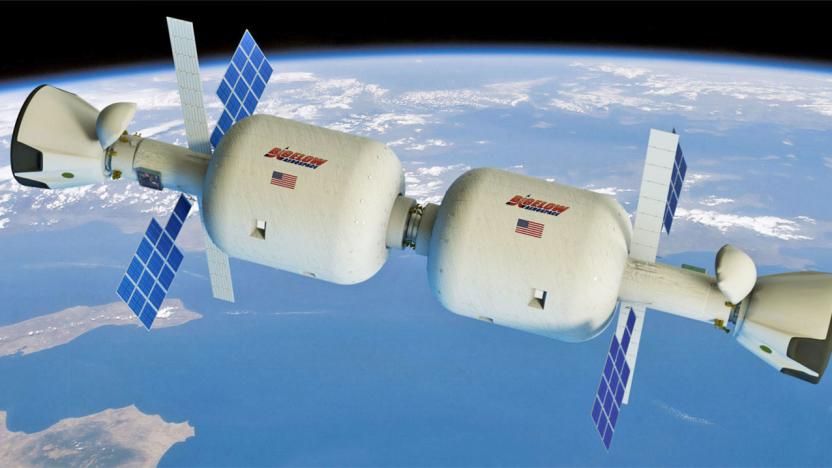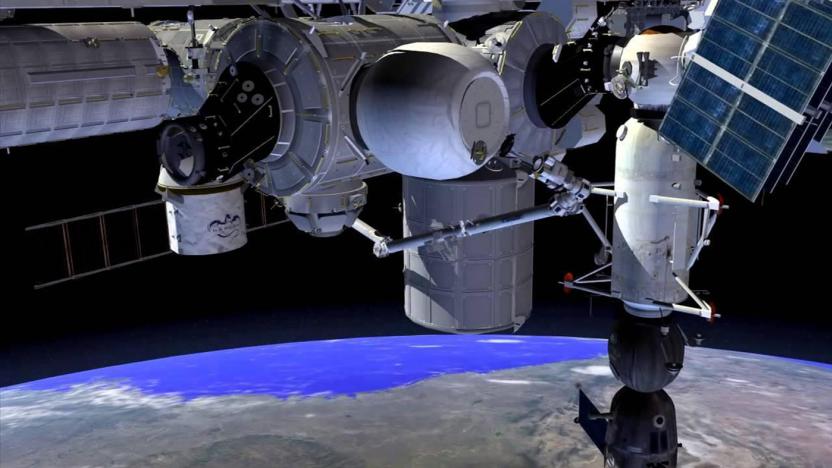bigelowaerospace
Latest

Bigelow forms command center for its expandable space stations
Bigelow Aerospace has big plans for its future expandable space stations, so it has formed a whole new company for them. Called Bigelow Space Operations (BSO), the new private space company will oversee the marketing and customer service, as well as become the operations center for the space habitats its parent corporation is developing. If you'll recall, Bigelow's inflatable module BEAM is currently being tested aboard the ISS. It's been doing so well NASA has decided to keep it around longer to be used as an on-orbit storage facility.

Astronauts climb into BEAM for the first time
Earlier, a couple of ISS crew members floated into BEAM to check on its condition for the first time ever. NASA astronaut Jeff Williams and Russian cosmonaut Oleg Skripochka collected air samples and downloaded data from the sensors inside the expandable module. The duo said that while it's quite cold inside, they didn't find any condensation -- but you don't have to take their word for it. They captured the inside of the module on camera, and you can see what it looks like in the video after the break.

NASA successfully puffs up its inflatable space habitat
Second time's the charm. Following a less-than-successful initial test run, NASA and Bigelow Aerospace have successfully inflated the Bigelow Expandable Activity Module attached to the International Space Station. It took several hours (the team didn't want any movement that could destabilize the station), but the experimental pod now extends nearly 5.6 feet out and 10.6 feet across. That's not the full size (it'll ultimately be 7 feet long), but it's hopefully smooth sailing from here on out.

NASA's first expandable habitat test on the ISS defeated by friction
NASA hopes that expandable habitats could dramatically expand livable space on the space station and Mars, but yesterday's first test on the ISS failed. Today, NASA and habitat builder Bigelow Aerospace announced the cause of the problem. After being packed away for an extended time, friction between fabrics increased pressure to unpredicted levels, endangering the habitat.

The ISS' first expandable habitat didn't unfold as planned
The ISS was supposed to have an expandable module attached to the Tranquility node by now -- alas, things didn't go well for NASA and Bigelow Aerospace. Space station crew member Jeff Williams spent two hours pumping air into the module through a small valve, but some unknown issues prevented BEAM from expanding to its full size. The space agency announced on Twitter when the attempt failed that it's working with Bigelow Aerospace to figure out what happened. It also said that it may try again later today (May 27th), but that might not push through. According to a follow-up tweet, they're holding a presscon at 12PM Eastern time today to update us space geeks on what they've found out and what their next steps are.

ISS' expandable module has a shield that protects it from debris
You had a lot of questions when we wrote about NASA gearing up to inflate BEAM on the ISS. Does it inflate like a balloon? What if it gets hit by micrometeoroids then? Does it protect against radiation? While there are many things we won't know for sure until the end of BEAM's two-year testing, NASA's and Bigelow Aerospace's Reddit AMA and Facebook Q&A could answer some Q's floating around your head. To start with, the team clarified that BEAM isn't an "inflatable." Its walls don't stretch like a balloon -- they're incredibly stiff and are "several times stronger per weight than metals commonly used in space applications." When the ISS crew expands the module on Thursday, the process could be more accurately described as "unfolding" rather than "inflating."

Watch NASA attach the first inflatable habitat on the ISS
On April 16th, the ISS will become just a wee bit bigger after astronauts install the Bigelow Expandable Activity Module. BEAM hitched a ride aboard SpaceX's Dragon capsule during its latest (and historic) resupply mission. Astronauts will use the robotic Canadarm2 to unload it from the capsule and move it to position, before unfolding and expanding it to add a 10-x-13-foot area to the station. If all goes well, BEAM will look like a small protrusion from outside the ISS, as you can see at the top center of the image above. The space agency will televise the installation live on NASA TV, so you can watch it go down... if you can wake up at 5:30AM (Eastern time) on a Saturday.

Inflatable space stations could orbit the Earth by 2020
The latest SpaceX launch ferried not just supplies for the ISS, but also an inflatable module designed to add a small living room on the space station. That module was made by Bigelow Aerospace, which has just announced that it teamed up with United Launch Alliance to send its much, much bigger inflatable stations called B330 to Low Earth Orbit. One B330 can add a 330-cubic-meter (or 12,000-cubic-foot) living space to the ISS -- that's 30 percent of its total size, whereas the model that piggybacked on Falcon 9 can only expand the station by five percent.

NASA to use the ISS as a testbed for inflatable living modules
NASA, perhaps more than anyone else, knows that there's only so much room for packing stuff onto a spacecraft. That's why it's testing expandable living modules on the International Space Station prior to sending them to Mars for work and living spaces. The Bigelow Expandable Activity Module will ride along in an upcoming SpaceX Dragon resupply mission to the ISS and from there will be unpacked and attached to the side of the station.

SpaceX and Bigelow Aerospace drum up support for the space hotel of the future
SpaceX and Bigelow Aerospace are teaming up to cross-promote their private aerospace tech. The duo are kicking off a tour in Asia to drum up governmental and business support for the Falcon 9 rocket and BA's BA 330 floating habitat. The latter has 330 cubic meters of space and can support a crew of six for scientific experimentation, or ensuring no-one can ever out-do your bachelor party. More details about the tie up are expected just as soon as Elon Musk's company can get that DragonX to escape the atmosphere.

Visualized: Boeing's CST-100 gets you and six friends to space... for cheap!
It's not expected to make its first jaunt to outer space before 2014, but Boeing's "low-cost" Crew Space Transportation-100 (CST-100) will allow up to seven Earthlings to travel up to 100 kilometers above the Earth's surface. The best part? Once you spend up to seven months docked at the International Space Station, you'll rely on "the aid of parachutes [as you head] to an airbag-cushioned landing on dry ground." Something tells us the crew of Jackass will be all over this in just a few years.

Experimental space hotel hurtled into orbit
Although we're not quite ready to pony up for a ticket to space just yet, billionaire Robert Bigelow is thinking way into the future by trialing a space hotel. Dubbed Genesis II, the inflatable module could eventually be used as a "hotel in space" or double as a manned space station, and considering that it only inflates once it settles in orbit, the cost of launching is substantially decreased. The experimental craft was successfully launched on board a Russian rocket, and has since established communications and "beamed back a series of images of its expanding solar panels." This endeavor is just the beginning, however, as Bigelow envisions a "full-scale space hotel" to be named Nautilus, and if you're interested in helping out (and making $50 million on the side), you've got three years to "design a craft capable of carrying five people to a height of 250 miles."[Image courtesy of Bigelow Aerospace]





